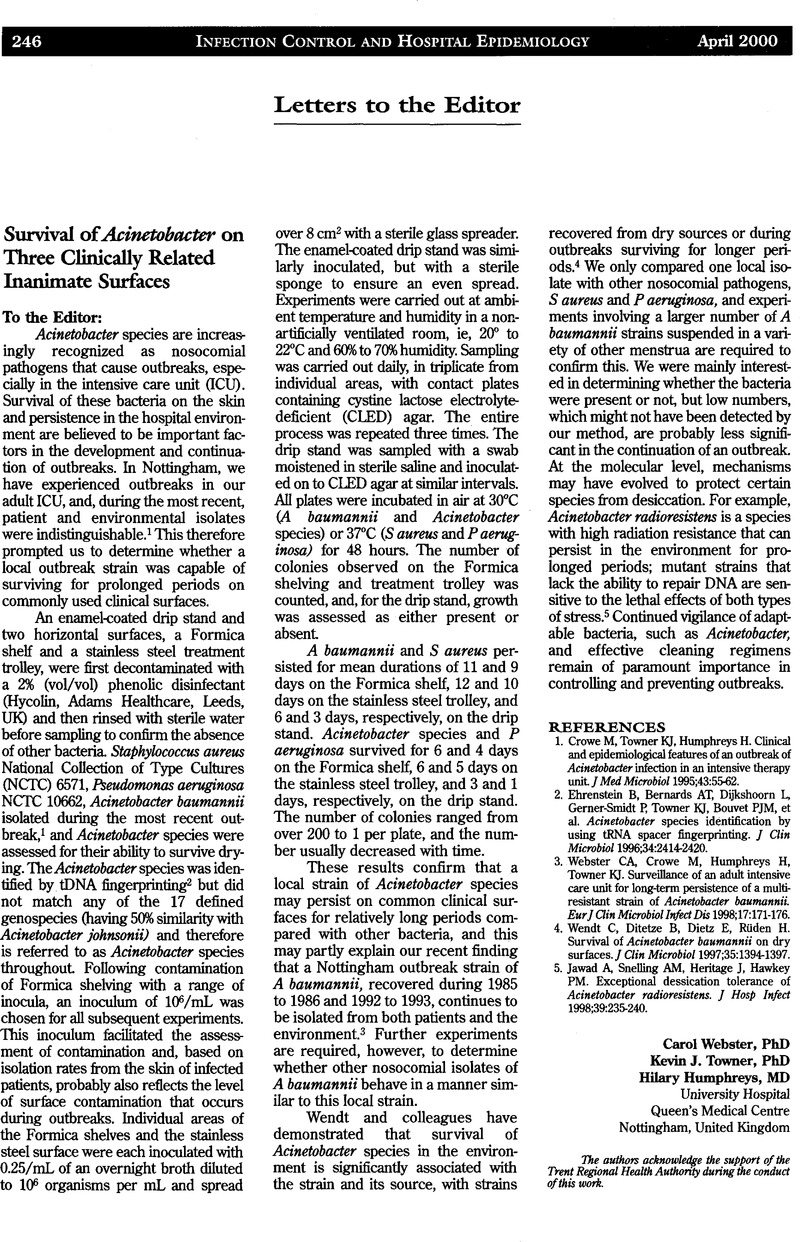Crossref Citations
This article has been cited by the following publications. This list is generated based on data provided by Crossref.
Koeleman, Johannes G.M.
van der Bijl, Madelon W.
Stoof, Jeroen
Vandenbroucke-Grauls, Christina M.J.E.
and
Savelkoul, Paul H.M.
2001.
Antibiotic Resistance Is a Major Risk Factor for Epidemic Behavior ofAcinetobacter baumannii.
Infection Control & Hospital Epidemiology,
Vol. 22,
Issue. 5,
p.
284.
Bayuga, Sharon
Zeana, Cosmina
Sahni, Jyoti
Della-Latta, Phyllis
El-Sadr, Wafaa
and
Larson, Elaine
2002.
Prevalence and antimicrobial patterns of Acinetobacter baumannii on hands and nares of hospital personnel and patients: The iceberg phenomenon again.
Heart & Lung,
Vol. 31,
Issue. 5,
p.
382.
Zeana, Cosmina
Larson, Elaine
Sahni, Jyoti
Bayuga, S. J.
Wu, Fann
and
Della-Latta, Phyllis
2003.
The Epidemiology of Multidrug-ResistantAcinetobacter BaumanniiDoes the Community Represent a Reservoir?.
Infection Control & Hospital Epidemiology,
Vol. 24,
Issue. 4,
p.
275.
Villegas, Maria Virginia
and
Hartstein, Alan I.
2003.
AcinetobacterOutbreaks, 1977–2000.
Infection Control & Hospital Epidemiology,
Vol. 24,
Issue. 4,
p.
284.
Kampf, Günter
and
Kramer, Axel
2004.
Epidemiologic Background of Hand Hygiene and Evaluation of the Most Important Agents for Scrubs and Rubs.
Clinical Microbiology Reviews,
Vol. 17,
Issue. 4,
p.
863.
Wroblewska, M.M
Dijkshoorn, L
Marchel, H
van den Barselaar, M
Swoboda-Kopec, E
van den Broek, P.J
and
Luczak, M
2004.
Outbreak of nosocomial meningitis caused by Acinetobacter baumannii in neurosurgical patients.
Journal of Hospital Infection,
Vol. 57,
Issue. 4,
p.
300.
Allen, Sam
2005.
Prevention and control of infection in the ICU.
Current Anaesthesia & Critical Care,
Vol. 16,
Issue. 4,
p.
191.
Kramer, Axel
Schwebke, Ingeborg
and
Kampf, Günter
2006.
How long do nosocomial pathogens persist on inanimate surfaces? A systematic review.
BMC Infectious Diseases,
Vol. 6,
Issue. 1,
Garnacho-Montero, J.
Leyba, C. O.
and
Martín, J. A.
2007.
Infectious Diseases in Critical Care.
p.
233.
Murray, Clinton K.
and
Hospenthal, Duane R.
2008.
Acinetobacter Infection in the ICU.
Critical Care Clinics,
Vol. 24,
Issue. 2,
p.
237.
2008.
21st ESICM Annual Congress.
Intensive Care Medicine,
Vol. 34,
Issue. S1,
p.
181.
Wisplinghoff, Hilmar
and
Seifert, Harald
2008.
Acinetobacter Biology and Pathogenesis.
p.
61.
Towner, K.J.
Levi, K.
and
Vlassiadi, M.
2008.
Genetic diversity of carbapenem-resistant isolates of Acinetobacter baumannii in Europe.
Clinical Microbiology and Infection,
Vol. 14,
Issue. 2,
p.
161.
Liguori, Giorgio
Bagattini, Maria
Gallè, Francesca
Quartucci, Valeria
Di Onofrio, Valeria
Negrone, Mario
and
Triassi, Maria
2009.
Microbiological evaluation of the efficacy of two new biodetergents on multidrug-resistant nosocomial pathogens.
Annals of Clinical Microbiology and Antimicrobials,
Vol. 8,
Issue. 1,
Kurcik-Trajkovska, Biljana
2009.
<i>Acinetobacter spp.</i> - A Serious Enemy Threatening Hospitals Worldwide.
Macedonian Journal of Medical Sciences,
Vol. 2,
Issue. 2,
p.
157.
Kawamura-Sato, Kumiko
Wachino, Jun-ichi
Kondo, Takaaki
Ito, Hideo
and
Arakawa, Yoshichika
2010.
Correlation between reduced susceptibility to disinfectants and multidrug resistance among clinical isolates of Acinetobacter species.
Journal of Antimicrobial Chemotherapy,
Vol. 65,
Issue. 9,
p.
1975.
Delahanty, Kim
and
Myers, Frank
2010.
3 bad bugs.
Nursing,
Vol. 40,
Issue. 3,
p.
24.
de Breij, Anna
Dijkshoorn, Lenie
Lagendijk, Ellen
van der Meer, Joke
Koster, Abraham
Bloemberg, Guido
Wolterbeek, Ron
van den Broek, Peterhans
Nibbering, Peter
and
Neyrolles, Olivier
2010.
Do Biofilm Formation and Interactions with Human Cells Explain the Clinical Success of Acinetobacter baumannii?.
PLoS ONE,
Vol. 5,
Issue. 5,
p.
e10732.
Delahanty, Kim
and
Myers, Frank
2010.
Tres malos bichos.
Nursing (Ed. española),
Vol. 28,
Issue. 7,
p.
14.
Kumar, Arvind
Mukherjee, Shriparna
and
Chakraborty, Ranadhir
2010.
Characterization of a Novel Trimethoprim Resistance Gene,dfrA28, in Class 1 Integron of an OligotrophicAcinetobacter johnsoniiStrain, MB52, Isolated from River Mahananda, India.
Microbial Drug Resistance,
Vol. 16,
Issue. 1,
p.
29.



